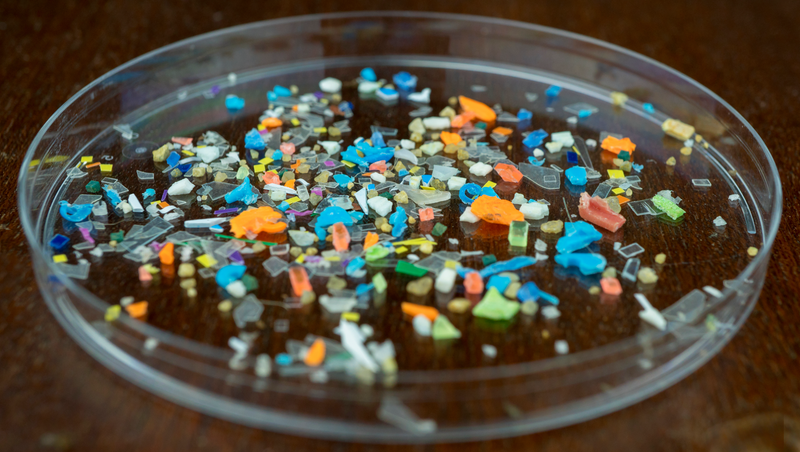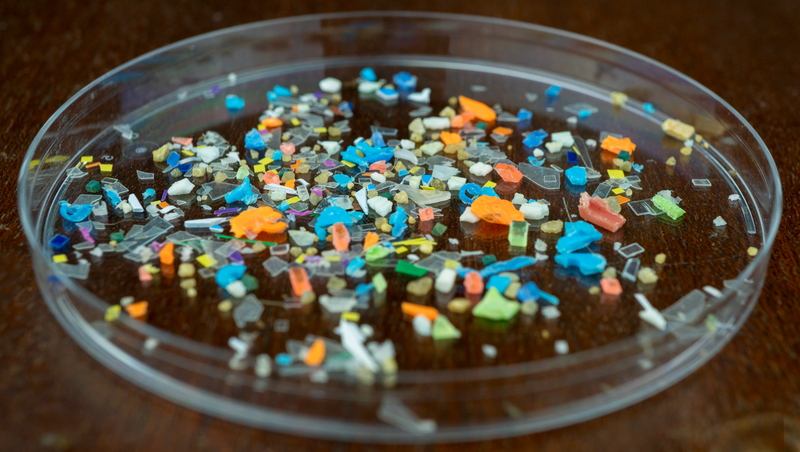Measuring the Rotation of Polluting Plastic Particles
Pollution from tiny plastic particles (microplastics) increasingly threatens ocean and river ecosystems, and potentially human health, but researchers don’t have a good understanding of how and where these pollutants are transported by flowing waters. Now a research team has observed 1.2-mm-long, 10-µm-wide strands—similar to the most common type of microplastic particles—as they moved in turbulent flows mimicking those in natural environments [1]. The experiments reveal new aspects of their motion, including the rates at which fibers spin around their long axes. The researchers hope that their results will help engineers design structures that can concentrate plastics for easier removal.
Scientists currently have a limited understanding of where microplastics tend to accumulate in the environment, says fluid dynamics expert Alfredo Soldati of the Vienna University of Technology. Where plastics gather depends on natural fluid flows and on the nature of the plastic objects themselves.
“Most oceanic microplastics are small and elongated microfibers,” he says, and much depends on how such microfibers rotate as they travel. Previous experimental studies have been able to measure the tumbling rate of a microfiber but not the rate of rotation around its long axis, known as the spinning rate. This rate has been measured only for thicker plastic cylinders about 1 mm in diameter and 5–10 mm in length, experiments in which researchers printed observable patterns on the cylinder surfaces [2].
To learn more about typical microplastics, Soldati and colleagues ran a series of experiments using a water channel 80 mm deep and 31 mm wide. Water flowed through this channel at 20 mm/s, fast enough to make the flow turbulent, especially near the walls. The researchers injected a dilute suspension of microplastic strands into the fluid. Each strand was 1.2 mm long and 10 µm wide. They then tracked the fibers’ trajectories using a high-resolution camera.
In general, they found that the microfibers’ tumbling rates—the number of rotations per second—depended strongly on the distance from the channel wall, with fibers tumbling faster near the wall where the flow was more turbulent. The team also measured the orientations of the strands, finding them more likely to align with the flow at the walls than at the center of the channel. These results on tumbling and alignment were consistent with similar measurements made previously by others.
Soldati and colleagues were able to measure the spinning rate because their microfibers had a slight curvature. In images, the profile of a curved strand changes as it spins, whereas that of a spinning straight fiber doesn’t change. This rate, they found, was consistently higher than the tumbling rate and also increased for strands nearer to the walls. The measured spinning rates were within 20% of those found previously using thicker cylinders [2].
Soldati says that this work focuses entirely on how flowing waters in realistic marine environments transport plastic microfibers rather than on developing any practical technology to remove plastic pollution. But he hopes this understanding will help future pollution removal efforts, for example, by allowing better predictions of where plastics are likely to settle. Researchers have been trying to understand how far plastic released in the ocean will travel before it settles on the ocean floor. “Currently, environmental and oceanic scientists do not have the ability to predict how fast objects will sink to the bottom,” he says. He hopes that further development of the basic science will make such predictions possible in the near future.
“[The] new technique for measuring spinning is great,” says mechanical engineer Michelle DiBenedetto of the University of Washington, an expert in environmental fluid dynamics. “As this is really fundamental work, it’s not perfectly clear how it might eventually help in removing microplastics from the environment. But microfibers are some of the most prevalent microplastics, and the data reported here are very valuable for furthering our understanding of microfibers’ behavior in turbulence generally.”
–Mark Buchanan
Mark Buchanan is a freelance science writer who splits his time between Abergavenny, UK, and Notre Dame de Courson, France.
References
- V. Giurgiu et al., “Full rotational dynamics of plastic microfibers in turbulence,” Phys. Rev. Lett. 133, 054101 (2024).
- T. B. Oehmke et al., “Spinning and tumbling of long fibers in isotropic turbulence,” Phys. Rev. Fluids 6, 044610 (2021).







